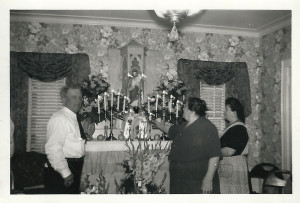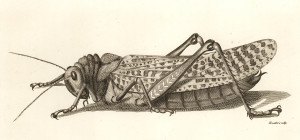It’s St. Joseph’s Day today, the 19th of March. When the Lenten season begins early, which this year it did not, St. Joseph’s Day arrives bringing a welcome respite from Lent’s bare-bones penitence in the form of decadent desserts. This year, we’re only two weeks into Lent at this point… but still, we’ll take the decadent desserts.
St. Joseph is sacred to Italy. He is a patron saint of children and of pastry chefs, both of whom typically have a fondness for sweets, and any Italian bakery worth its salt today will be selling at least a couple of pastries made especially for San Giuseppe. It’s a good sign if you walk into one such bakery today and see trays and trays of zeppole and sfinci. Both are pastries of fried dough, generous in size, each typically something you could fit into two open hands. Zeppole are filled with custard and often include a few cherries on top. Sfinci are filled with sweetened ricotta cream, perhaps with a few small chocolate chips, very much like a cannoli filling. Many Italian bakeries sell these pastries for a few weeks before and after St. Joseph’s Day, but today is their traditional day, and we take that first bite into a delectable zeppole, with the aroma of strong espresso in the air, and we thank San Giuseppe for bringing a bit of sweetness to Lent’s otherwise stark and penitent nature.
Variations of these sweets, in name and in shape and ingredients, exist throughout Italy for the feast of San Giuseppe, but it is in the South, from where my family hails, that they are best known. Both sfinci and zeppole are pastries with histories that go back many centuries, with names that come out of the Arabic influence on the region. How far back do they go? The ancient Romans made fried pastries each year on the 17th of March in honor of Bacchus, and it is thought that the zeppole and sfinci we make today are direct descendants of those springtime sweets.
Both of my grandmothers were devotees of San Giuseppe. Many years before I was born, Grandma Cutrone used to prepare an altar to St. Joseph each year for his feast day. My dad would help her set up the altar in their home, and on it Grandma would place breads and ceci beans and oranges and animal crackers for the children. There are old 8 mm black and white home movies of friends and neighbors coming in to see the altar and pay their respects. The priest would come to bless it, and Grandma Cutrone would give each person who visited an orange to take home with them.
My Grandma Assunta did not have such an altar in her home, but she would often pray to San Giuseppe, and we couldn’t leave church each Sunday before she lit the big candle at St. Joseph’s statue in the chapel. We would visit him each week there. To this day, every time I go to a church, I light a candle for her, because that’s what she would do, and it’s one of many ways I have of keeping in touch with those who came before us.
I’m glad they both loved St. Joseph so much. A good friend of ours, Father Philip Joly, recently helped me see St. Joseph in a new light. St. Joseph, who is also a patron saint of families, is almost always depicted as an old man. The truth is, though, Mary was probably just a teenager when the angel came to tell her she would be giving birth to a son, the son of God. Joseph, who was engaged to her, was probably not much older himself, and he, too, received a visit from the angel saying, “Don’t be afraid.” There he was, a young man, with a pregnant teenage wife, pregnant not by him, asked to become a father to a son that was not his. That’s a lot to swallow, no? But he supported his betrothed, and he went through with it. He had compassion, and he had faith. Joseph’s family was no ordinary family. And so when we think of San Giuseppe as the patron saint of families, we know that that extends to all families, no matter how traditional or non-traditional they may be. What a guy.
Image: That’s Grandma Cutrone on the right, Grandpa Cutrone on the left, my dad’s Aunt Carmela between them, and the altar to San Giuseppe in their home for St. Joseph’s Day, circa 1940s, Brooklyn, New York.


